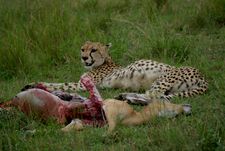Impala
| Impala | |
|---|---|
.jpg) |
|
| In Tanzania | |
| Conservation status | |
| Scientific classification | |
| Kingdom: | Animalia |
| Phylum: | Chordata |
| Class: | Mammalia |
| Order: | Artiodactyla |
| Family: | Bovidae |
| Subfamily: | Aepycerotinae Gray, 1872 |
| Genus: | Aepyceros Sundevall, 1847 |
| Species: | A. melampus |
| Binomial name | |
| Aepyceros melampus (Lichtenstein, 1812) |
|
| Subspecies | |
|
|
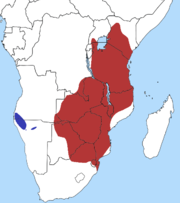 |
|
| Distribution of the Impala Red =A. m. melampus Blue = A. m. petersi |
|
An impala (Aepyceros melampus Greek αιπος, aipos "high" κερος, ceros "horn" + melas "black" pous "foot") is a medium-sized African antelope. The name impala comes from the Zulu language meaning "Gazelle". They are found in savannas and thick bushveld in Kenya, Tanzania, Swaziland, Mozambique, northern Namibia, Botswana, Zambia, Zimbabwe, southern Angola, northeastern South Africa and Uganda. Impalas can be found in numbers of up to 2.000.000 in Africa [2].
Contents |
Taxonomy
In the past, taxonomists have put the impala in the same tribe as gazelles, kobs and hartebeests. However it was found that the impala was so different from any of these tribes that it was put in its own tribe, Aepycerotini respectively. This tribe has now been elevated to full subfamily status.
Usually two subspecies are distinguished, which is supported by mitochondrial DNA analysis[3]:
- Black-faced Impala Aepyceros melampus petersi
- Common Impala Aepyceros melampus melampus
Appearance
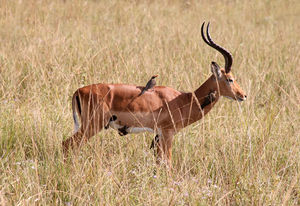
Impalas range between 73 to 92 cm (29 to 36 in) tall. Average mass for a male Impala is approximately 46 to 76 kg (100 to 170 lb) while females weigh approximately 37 to 50 kg (82 to 110 lb). They are normally reddish-brown in color (hence the Afrikaans name of "Rooibok"), have lighter flanks and white underbellies with a characteristic "M" marking on its rear. Males, referred to as rams, have lyre-shaped horns which can reach up to 90 centimeters in length. Females, referred to as ewes, have no horns.
Black impala
The black impala, found in very few places in Africa, is an extremely rare type of impala. Botlierskop Private Game Reserve in South Africa has over 150 black impala and even more red impala. These animals can form large breeding herds of up to 100 individuals, but usually only congregate in the region of 20. A reccessive gene found in the black impala gives it its black colouration.
Ecology
Impalas are among the dominant species in many savannas. They can adapt to different environment by being grazers in some areas and browsers in others. They graze when the grass is green and growing and browse at other times. They will browse on shoots, seedpods and foliage.
Herds will use specific areas for their excrement. Impala are active during both day and night and are dependent on water. A herd is normally an indicator of water close by. Impala can thrive in areas where pure grazers can not survive.
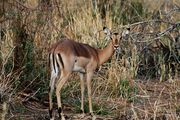
When frightened or startled the whole impala herd starts leaping about in order to confuse their predator. They can jump distances more than 10 meters (33 ft) and 3 meters (9 ft) high. Leopards, cheetah, lions and wild dogs prey on impala. Impala can reach running speeds of approximately 80 to 90 km/h (50 to 56 mph) [4], to escape its predators. When escaping from predators, they can release a scent from their glands on their heels which can help them stay together. This is done by performing a high kick of their hind legs.
Social structure and reproduction
Females and young form herds of up to two hundred individuals. When food is plentiful, adult males will establish territories and round up any female herd that enter their grounds and will chase away bachelor males that follow. They will even chase away recently weaned males. A male impala tries to prevent any female from leaving its territory. During the dry seasons, territories are abandoned as herds must travel farther to find food. Large, mixed tranquil herds of females and males form.
Young male impala who have been made to leave their previous herd form bachelor herds of around thirty individuals. Males that are able to dominate their herd are contenders for assuming control of their territory.
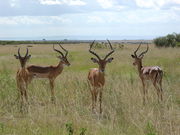
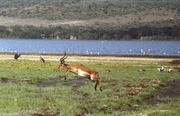
The breeding season of impala, also called rutting, begins toward the end of the wet season in May. The entire affair typically lasts approximately three weeks. While young are born after seven months, the mother has the ability to delay giving birth for an additional month if conditions are harsh. When giving birth a female impala will isolate herself from the herd despite numerous attempts by the male to keep her in his territory. The impala mother will keep the fawn in an isolated spot for a few days or even leave it lying out in hiding for a couple days, weeks, or more before returning to the herd. There the fawn will join a nursery group and will go to its mother only to nurse and when predators are near. Fawns are suckled for 4 to 6 months. Males who mature are forced out of the group and will join bachelor herds.
Gallery
 Female impala |
 A Groups of female impala |
 Impala leaping from the water |
A group of impala in South Africa |
 Impala in Zambia |
 Male impala |
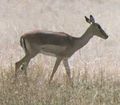 Female impala |
 Female impala |
|
A group of Tanzanian impala |
Female impala |
Male impala challenging, in Etosha, Namibia |
See also
References
- ↑ IUCN SSC Antelope Specialist Group (2008). Aepyceros melampus. In: IUCN 2008. IUCN Red List of Threatened Species. Downloaded on 18 January 2009. Database entry includes a brief justification of why this species is of least concern
- ↑ http://www.iucnredlist.org/apps/redlist/details/550/0/full
- ↑ LOUISE GRAU NERSTING and PETER ARCTANDER: Phylogeography and conservation of impala and greater kudu. Molecular Ecology (2001) 10 , 711–719 online
- ↑ http://www.safari-photo.org/zebrei.html
- Estes, R. (1991). The Behavior Guide to African Mammals, Including Hoofed Mammals, Carnivores, Primates. Los Angeles, The University of California Press
- African Wildlife Fundation - Impala
- Arkive - Impala
- [1]
External links
|
||||||||||||||||||||||||||||||||||||||||||||||||||||||||||||||||||||||||||||||||||||||||||||||||||||||||||||||||||||||||||||||||||||||||||||||||||||||||||||||||||||||||||||||||||||||||||||||||||||||||||||||||||||||||||||||||||||||||||||||||||||||||||||||||||||||||||||||||||||||||||||||||||||||||||||||||||||||||||||||||||||||||||||||||||||||||||||||||||||||||||||||||||||||||||||||||||||
